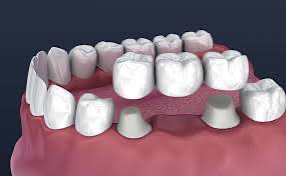Taking care of your teeth goes beyond regular brushing and flossing. Dental issues like tooth decay, cracks, or even missing teeth sometimes require more help to restore your smile. Dental crowns and bridges are two of the most popular therapeutic solutions available. This guide will walk you through the differences, benefits, and situations where each option might be ideal, helping you make an informed choice for your dental health.
Dental crowns Turkey are like caps placed over damaged or weakened teeth. They restore the tooth’s shape, size, and strength while improving its appearance. Crowns are commonly made from materials like porcelain, ceramic, metal, or resin, each offering unique advantages in durability and aesthetics. Crowns are ideal for protecting a tooth from further damage, giving it the support it needs to function properly.
Dental bridges are designed to “bridge” the gap created by one or more missing teeth. A bridge consists of a false tooth (or teeth) called a pontic, held in place by the adjacent teeth, known as abutments. Bridges come in several types: traditional, cantilever, Maryland, and implant-supported. They are an effective way to restore a natural-looking smile and support proper chewing and speaking abilities.
The Differences Between Crowns and Bridges
Crowns and bridges sound similar, but they serve different purposes. To protect and restore, crowns cover individual teeth, often damaged or decayed. Bridges, on the other hand, replace missing teeth by anchoring to neighboring teeth. Crowns are singular restorations, while bridges involve multiple connected components to span a gap in your smile.
When Are Dental Crowns Recommended?
Dentists recommend crowns in several cases, including:
● Protecting a weakened or cracked tooth
● Covering a large filling or dental implant
● Following a root canal to provide additional support
Crowns are typically used for individual teeth and can last a long time with proper care, though they may not be suitable for everyone, especially those with gum disease or severely damaged tooth structure.
When Are Dental Bridges Recommended?
Dental bridges are ideal for patients missing one or more teeth in a row. By filling the gap, bridges help maintain facial shape, prevent neighboring teeth from shifting, and restore your smile. However, bridges require adjacent teeth for support, so your dentist will evaluate whether those teeth are strong enough to support the bridge.
Materials Used in Crowns and Bridges
Both crowns and bridges come in various materials, each offering different benefits:
● Porcelain: Mimics the natural look of teeth, ideal for front teeth
● Ceramic: Durable and often used for visible teeth
● Metal and Porcelain Fused: Offers strength with a natural appearance
● Resin: Generally more affordable, though less durable than other materials
Choosing the right material depends on location, budget, and aesthetic preference.
The Procedure for Getting a Crown
The crown placement process involves several steps:
● Initial Visit: The tooth is examined and prepared, with impressions taken
● Crown Creation: A dental lab customizes the crown to fit your tooth
● Placement: On a follow-up visit, the crown is fitted and bonded to your tooth
After the procedure, avoiding sticky or hard foods can help extend the crown’s lifespan.
The Procedure for Getting a Bridge
Getting a bridge requires a few appointments:
● Preparation: The abutment teeth are reshaped to fit crowns
● Impression: A model is created for the bridge structure
● Fitting and Bonding: On the final visit, the bridge is adjusted and secured in place
Proper care, like daily brushing and flossing, keeps your bridge in top condition.
Benefits and Drawbacks of Dental Crowns
Benefits:
● Protects and strengthens damaged teeth
● It can last many years with good care
● Blends well with natural teeth
Drawbacks:
● Costly, especially if not covered by insurance
● It may require replacement after extended use
Benefits and Drawbacks of Dental Bridges
Benefits:
● Restores function and appearance by replacing missing teeth
● Prevents shifting of adjacent teeth
● Typically, it lasts a long time with proper care
Drawbacks:
● It can affect adjacent teeth by requiring support from them
● May need replacement every 10-15 years
Which Is Right for You: Crowns or Bridges?
Consider your dental needs, budget, and lifestyle when choosing between crowns and bridges. Consulting with a dentist can help you understand which solution best aligns with your goals, especially if you’re unsure about suitability or cost.
How to Care for Your Crown or Bridge
Regular care can extend the lifespan of your dental restoration:
● Brush and floss daily, especially around the gumline
● Avoid hard, sticky foods that can damage the restoration
● Schedule regular dental check-ups to monitor wear and address issues early
Dental crowns and bridges offer durable, effective ways to restore your smile, so consult your dentist for personalized guidance. You’ll enjoy a healthy, functional, and beautiful smile for years with the right approach!
Ready to restore your smile with confidence? Visit DentaVivo today to explore options and find the perfect solution for your dental needs! Our expert team is here to guide you every step of the way.

